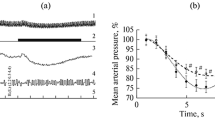Conclusions
-
1.
Reversible blocking of some nonspecific thalamic and hypothalamic nuclei differs in its effect on two types of spatial synchronization of cortical potentials (SSCP) formed during defensive conditioned reflex (DCR) formation: Specific local SSCP and conditionedreflex movements disappear, whereas global SSCP remains virtually unchanged under these circumstances in interstimulus periods.
-
2.
By modifying their functional state of these nuclei by anodal polarization it is possible to influence the rate of DCR formation. The effect of polarization depends on the structure to be stimulated and the stage of reflex formation.
-
3.
During temporary blocking of hypothalamic nuclei phasic changes arise in local SSCP, which was never observed after blocking the nonspecific thalamic nuclei.
-
4.
During reversible blockade of subcortical structures synchronization of cortical and subcortical potentials is depressed first. Conditioned-reflex movements appear only when synchronization between cortex and subcortex is recovered.
-
5.
The conclusion can be drawn from the results that the mammillary bodies play an important role in the formation of local SSCP at the beginning of DCR formation and that the nonspecific thalamic nuclei and the posterior hypothalamic nucleus are essential for this form of spatial synchronization to arise on stabilization of the reflex, when definite correlation is observed between the appearance of local, specific SSCP, realization of the reflex, and strengthening of synchronization between the cortex and subcortical formations.
Similar content being viewed by others
Literature cited
O. S. Adrianov, Zh. Vyssh. Nerv. Deyat.,10, No. 6, 851 (1960).
É. A. Asratyan, Priroda,12, 74 (1937).
É. A. Asratyan, Zh. Vyssh. Nerv. Deyat.,12, No. 3, 371 (1962).
I. N. Knipst, in: Current Problems in Electrophysiology of the Central Nervous System [in Russian], Nauka, Moscow (1967), p. 127.
A. B. Kogan, Zh. Vyssh. Nerv. Deyat.,11, No. 4, 651 (1961).
M. N. Livanov, The Spatial Organization of Brain Processes [in Russian], Nauka, Moscow (1972).
M. N. Livanov, Usp. Fiziol. Nauk,6, No. 3, 66 (1975).
T. I. Luchkova, “Spatial synchronization of cerebral cortical potentials during defensive conditioning,” Author's Abstract of Candidate's Dissertation, Moscow, Institute of Higher Nervous Activity and Neurophysiology, Academy of Sciences of the USSR (1973).
T. I. Luchkova, Zh. Vyssh. Nerv. Deyat.,23, No. 3, 622 (1973).
T. I. Luchkova and A. M. Sherstov, in: Functional Role of Electrical Processes of the Brain [in Russian], Nauka, Moscow (1977), p. 42.
A. M. Mamedov, “Dynamics of cortico—subcortical relations in experimental emotional stress,” Author's Abstract of Doctoral Dissertation, Moscow, Institute of Normal Physiology, Academy of Medical Sciences of the USSR (1975).
K. A. Nikol'skaya, and L. G. Voronin, Zh. Vyssh. Nerv. Deyat.,27, No. 3, 513 (1977).
L. A. Plakkhinas and Yu. A. Katkov, Proceedings of the 23rd Conference on Problems in Higher Nervous Activity [in Russian], Vol. 1, Gor'kii (1972), p. 115.
L. A. Plakkhinas and I. V. Nesterova, in: Physiological Mechanisms of Memory [in Russian], Pushchino-on-Oka (1973), p. 107.
I. Ya. Podol'skaya and V. V. Vorob'ev, in: Physiological Mechanisms of Memory [in Russian], Pushchino-on-Oka (1973), p. 117.
V. S. Rusinov, “The dominant focus. Electrophysiological investigations,” [in Russian], Meditsina, Moscow (1969).
K. A. Soldatova and N. A. Tushmalova, Zh. Vyssh. Nerv. Deyat.,21, No. 4, 706 (1971).
K. V. Sudakov, Fiziol. Zh. SSSR,49, No. 8, 901 (1963).
Z. A. Yanson and V. P. Markin, in: The Functional Role of Brain Electrical Processes [in Russian], Nauka, Moscow (1977), p. 103.
D. Dahl, W. R. Ingram, and J. R. Knott, Arch. Neurol.,7, No. 4, 314 (1962).
D. W. Ploog and P. D. McLean, Exp. Neurol.,7, No. 1, 76 (1963).
J. Rosenstock, T. D. Field, and E. Greene, Exp. Neurol.,55, No. 2, 340 (1977).
M. Rose, J. Psychol. Neurol.,43, 353 (1931).
C. H. Sawyer, J. Everett, and J. D. Green, J. Comp. Neurol.,101, No. 3, 801 (1954).
R. Thompson and W. Hawkins, Exp. Neurol.,3, No. 2, 189 (1961).
Author information
Authors and Affiliations
Additional information
Translated from Zhurnal Vysshei Nervnoi Deyatel'nosti, Vol. 29, No. 5, pp. 930–937, September–October, 1979.
Rights and permissions
About this article
Cite this article
Luchkova, T.I. Effect of anodal polarization of deep brain structures on spatial synchronization of cortical potentials during defensive conditioning in rabbits. Neurosci Behav Physiol 11, 543–549 (1981). https://doi.org/10.1007/BF01186830
Received:
Issue Date:
DOI: https://doi.org/10.1007/BF01186830



